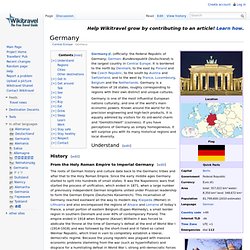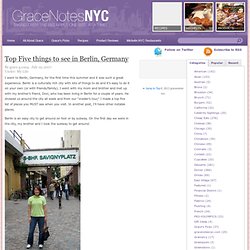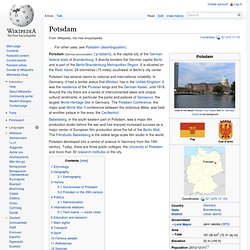

Germany travel guide. Germany, (officially: the Federal Republic of Germany; German: Bundesrepublik Deutschland) is the largest country in Central Europe.

It is bordered to the north by Denmark, to the east by Poland and the Czech Republic, to the south by Austria and Switzerland, and to the west by France, Luxembourg, Belgium and the Netherlands. Germany is a federation of 16 states, roughly corresponding to regions with their own distinct and unique cultures. Germany is one of the most influential European nations culturally, and one of the world's main economic powers. Known around the world for its precision engineering and high-tech products, it is equally admired by visitors for its old-world charm and "Gemütlichkeit" (coziness). If you have perceptions of Germany as simply homogeneous, it will surprise you with its many historical regions and local diversity.
Understand[edit] History[edit] From the Holy Roman Empire to Imperial Germany[edit] Hitler and Nazi Germany[edit] It was "Stunde Null" or zero hour. Berlin travel guide. Berlin Berlin is a huge city with several district articles containing sightseeing, restaurant, nightlife and accommodation listings — have a look at each of them.

East Side Gallery - "The mind is like the trail of birds in the sky" Berlin is the capital city of Germany and one of the 16 states (Länder) of the Federal Republic of Germany. Berlin is the largest city in Germany and has a population of 4.5 million within its metropolitan area and 3.5 million from over 190 countries within the city limits. Berlin is best known for its historical associations as the German capital, internationalism and tolerance, lively nightlife, its many cafés, clubs, bars, street art, and numerous museums, palaces, and other sites of historic interest. It is now possible to see representatives of many different historic periods in a short time within the city centre, from a few surviving medieval buildings near Alexanderplatz, to the ultra modern glass and steel structures at Potsdamer Platz.
Districts[edit] Top Five things to see in Berlin, Germany. By grace.g.yang · July 19, 2007 Under: My Life I went to Berlin, Germany, for the first time this summer and it was such a great experience.

Berlin is a culturally rich city with lots of things to do and it’s easy to do it on your own (or with friends/family). I went with my mom and brother and met up with my brother’s friend, Dovi, who has been living in Berlin for a couple of years. He showed us around the city all week and from our “insider’s tour,” I made a top five list of places you MUST see when you visit. In another post, I’ll have other notable places. Berlin is an easy city to get around on foot or by subway. The subways are partially elevated and partially underground and the train cars are very short compared to the ones in New York. 1.
A. The Brandenburg Gate is one of the major historical landmarks in Berlin. When the Nazis rose to power, they used the gate to symbolize their power. B. C. Berlin and Potsdam Tourist tour (HD Video) Potsdam. Potsdam (German pronunciation: [ˈpɔtsdam]), is the capital city of the German federal state of Brandenburg.

It directly borders the German capital Berlin and is part of the Berlin/Brandenburg Metropolitan Region. It is situated on the River Havel, 24 kilometres (15 miles) southwest of Berlin's city center. Babelsberg, in the south-eastern part of Potsdam, was a major film production studio before the war and has enjoyed increased success as a major center of European film production since the fall of the Berlin Wall.
The Filmstudio Babelsberg is the oldest large-scale film studio in the world. Potsdam developed into a centre of science in Germany from the 19th century. Etymology[edit] The name "Potsdam" originally seems to have been Poztupimi. Geography[edit] Templiner See south of Potsdam The area was formed from a series of large moraines left after the last glacial period. Demography[edit] Recent Population Development (Blue Line) and Forecasts History[edit] Stadtschloss Potsdam in 1773.